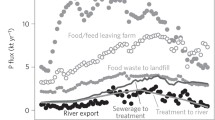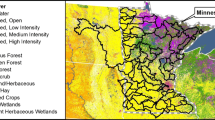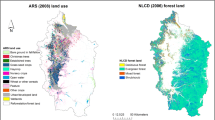Abstract
We estimated net anthropogenic phosphorus inputs (NAPI) to 18 Lake Michigan (LM) and 6 Lake Erie (LE) watersheds for 1974, 1978, 1982, 1987, and 1992. NAPI quantifies all anthropogenic inputs of P (fertilizer use, atmospheric deposition, and detergents) as well as trade of P in food and feed, which can be a net input or output. Fertilizer was the dominant input overall, varying by three orders of magnitude among the 24 watersheds, but detergent was the largest input in the most urbanized watershed. NAPI increased in relation to area of disturbed land (R2 = 0.90) and decreased with forested and wetland area (R2 = 0.90). Export of P by rivers varied with NAPI, especially for the 18 watersheds of LM (R2 = 0.93), whereas the relationship was more variable among the six LE watersheds (R2 = 0.59). On average, rivers of the LE watersheds exported about 10% of NAPI, whereas LM watersheds exported 5% of estimated NAPI. A comparison of our results with others as well as nitrogen (N) budgets suggests that fractional export of P may vary regionally, as has been reported for N, and the proportion of P inputs exported by rivers appears lower than comparable findings with N.





Similar content being viewed by others
Abbreviations
- LE:
-
Lake Erie
- LM:
-
Lake Michigan
- NANI:
-
Net anthropogenic nitrogen input
- NAPI:
-
Net anthropogenic phosphorus input
- NLCD:
-
National Land Cover Database
- RMSE:
-
Root mean squared error
References
Alexander RB, Smith RA (1990) County-level estimates of nitrogen and phosphorus fertilizer use in the United States, 1945 to 1985. USGS, Reston, VA
Alexander RB, Smith RA (2006) Trends in the nutrient enrichment of US rivers during the late 20th century and their relation to changes in probable stream trophic conditions. Limnol Oceanogr 51:639–654
Baker DB (1993) The Lake Erie Agroecosystem Program—water-quality assessments. Agric Ecosyst Environ 46:197–215
Baker DB, Richards RP (2002) Phosphorus budgets and riverine phosphorus export in northwestern Ohio watersheds. J Environ Qual 31:96–108
Battaglin WA (1994) Fertilizer sales data 1986 to 1991. U.S. EPA, Office of Policy Planning and Evaluation, Lakewood, CO
Borbor-Cordova MJ, Boyer EW, McDowell WH, Hall CA (2006) Nitrogen and phosphorus budgets for a tropical watershed impacted by agricultural land use: Guayas, Ecuador. Biogeochemistry 79:135–161
Bosch NS, Allan JD (2008) The influence of impoundments on nutrient budgets in two catchments of Southeastern Michigan. Biogeochemistry 87:325–338
Boyer EW, Goodale CL, Jaworsk NA, Howarth RW (2002) Anthropogenic nitrogen sources and relationships to riverine nitrogen export in the northeastern USA. Biogeochemistry 57:137–169
Brenner TE (1987) Soaps and detergents—North-American trends. J Am Oil Chem Soc 64:251–256
Burns NM, Rockwell DC, Bertram PE, Dolan DM, Ciborowski JJH (2005) Trends in temperature, Secchi depth, and dissolved oxygen depletion rates in the central basin of Lake Erie, 1983–2002. J Great Lakes Res 31:35–49
Calhoun FG, Bigham JM, Slater BK (2002) Relationships among plant available phosphorus, fertilizer sales, and water quality in northwestern Ohio. J Environ Qual 31(1):38–46
Chapra SC (1980) Simulation of recent and projected total phosphorus trends in Lake Ontario Canada USA. J Great Lakes Res 6:101–112
Cohn TA, Delong LL, Gilroy EJ, Hirsch RM, Wells DK (1989) Estimating constituent loads. Water Resour Res 25:937–942
CTIC (Conservation Tillage Information Center) (2009) Crop residue management statistics. http://www.conservationinformation.org/index.asp
Daly C, Gibson W (2002) 103-Year high-resolution precipitation climate data set for the conterminous United States. Spatial Climate Analysis Service, Corvallis, OR
David MB, Gentry LE (2000) Anthropogenic inputs of nitrogen and phosphorus and riverine export for Illinois, USA. J Environ Qual 29:494–508
Dyble J, Fahnenstiel GL, Litaker RW, Millie DF, Tester PA (2008) Microcystin concentrations and genetic diversity of microcystis in the lower Great Lakes. Environ Toxicol 23(4):507–516
Fullerton DS, Bush CA, Pennell JN (2004) Surficial deposits and materials in the eastern and central United States. USGS. http://pubs.usgs.gov/imap/i-2789
GLWQB (Great Lakes Water Quality Board) (1980) Report on Great Lakes Water Quality. International Joint Commission (IJC), Windsor, Ontario
GLWQB (Great Lakes Water Quality Board) (1981) Report on Great Lakes Water Quality. International Joint Commission (IJC), Windsor, Ontario
GLWQB (Great Lakes Water Quality Board) (1983) Report on Great Lakes Water Quality. International Joint Commission (IJC), Windsor, Ontario
GLWQB (Great Lakes Water Quality Board) (1985) Report on Great Lakes Water Quality. International Joint Commission (IJC), Windsor, Ontario
GLWQB (Great Lakes Water Quality Board) (1987) Report on Great Lakes Water Quality. International Joint Commission (IJC), Windsor, Ontario
GLWQB (Great Lakes Water Quality Board) (1989) Report on Great Lakes Water Quality. International Joint Commission (IJC), Windsor, Ontario
GLWQB (Great Lakes Water Quality Board) (1992) Report on Great Lakes Water Quality. International Joint Commission (IJC), Windsor, Ontario
Goolsby DA, Battaglin WA, Lawrence GB, Artz RS, Aulenbach BT, Hooper RP, Keeney DR, Stensland GJ (1999) Flux and sources of nutrients in the Mississippi-Atchafalaya River Basin: topic 3 report for the integrated assessment on hypoxia in the Gulf of Mexico. NOAA Coastal Ocean Office, Silver Spring, MD
Han HJ, Allan JD (2008) Estimation of nitrogen inputs to catchments: comparison of methods and consequences for riverine export prediction. Biogeochemistry 91:177–199
Han HJ, Allan JD, Scavia D (2009) Influence of climate and human activities on the relationship between watershed nitrogen input and river export. Environ Sci Technol 43:1916–1922
Howarth RW, Billen G, Swaney D, Townsend A, Jaworski N, Lajtha K, Downing JA, Elmgren R, Caraco N, Jordan T, Berendse F, Freney J, Kudeyarov V, Murdoch P, Zhao-Liang Zhu (1996) Regional nitrogen budgets and riverine N & P fluxes for the drainages to the North Atlantic Ocean: natural and human influences. Biogeochemistry 35:75–139
Howarth RW, Swaney DP, Boyer EW, Marino R, Jaworski N, Goodale C (2006) The influence of climate on average nitrogen export from large watersheds in the Northeastern United States. Biogeochemistry 79:163–186
Kellogg RL, Lander CH, Moffitt D, Noel G (2000) Manure nutrients relative to the capacity of cropland and pastureland to assimilate nutrients: spatial and temporal trends for the United States. U.S. Department of Agriculture, Natural Resources Conservation Service, Kansas
Ligman K, Hutzler N, Boyle WC (1974) Household wastewater characterization. J Environ Eng Div (ASCE) 100:201–213
Litke DW (1999) Review of phosphorus control measures in the United States and their effects on water quality. USGS, Denver, CO
McIsaac GF, David MB, Gertner GZ, Goolsby DA (2001) Eutrophication—nitrate flux in the Mississippi river. Nature 414:166–167
MRLC (Multi-Resolution Land Characteristics) (1995) Consortium documentation notebook; national land cover database. http://www.epa.gov/mrlc/nlcd.html
NCWQR (The National Center for Water Quality Research) (2008) Heidelberg College, Tiffin, Ohio. http://www.heidelberg.edu/wql
NRC (National NRC Research Council) (1984) Nutrient requirements of beef cattle. National Academy Press, Washington, DC
NRC (National NRC Research Council) (1985) Nutrient requirements of sheep. National Academy of Press, Washington, DC
NRC (National NRC Research Council) (1998) Nutrient requirements of swine. National Academy Press, Washington, DC
NRC (National NRC Research Council) (2001) Nutrient requirements of dairy cattle. National Academy Press, Washington, DC
Ouellette AJA, Handy SM, Wilhelm SW (2006) Toxic microcystis is widespread in Lake Erie: PCR detection of toxin genes and molecular characterization of associated cyanobacterial communities. Microb Ecol 51(2):154–165
PLAURG (1977) Atmospheric loading of the lower Great Lakes and the Great Lakes Drainage Basin. International Joint Commission (IJC), Windsor, Ontario
PLAURG (1978) Environmental management strategy for the Great Lakes system: final report of PLUARG to IJC. International Joint Commission (IJC), Windsor, Ontario
Richards RP (1998) Estimation of pollutant loads in rivers and streams: a guidance document for NPS Programs. Heidelberg College, Water Quality Laboratory, Tiffin, OH
Rosa F, Burns NM (1987) Lake Erie central basin oxygen depletion changes from 1920–1980. J Great Lakes Res 13:684–696
Royer TV, David MB, Gentry LE (2006) Timing of riverine export of nitrate and phosphorus from agricultural watersheds in Illinois: implications for reducing nutrient loading to the Mississippi River. Environ Sci Technol 40:4126–4131
Ruddy BC, Lorenz DL, Mueller DK (2006) County-level estimates of nutrient inputs to the land surface of the conterminous United States, 1982–2001. U.S. Geological Survey Scientific Investigations Report 2006-5012, Denver, CO
Russell MJ, Weller DE, Jordan TE, Sigwart KJ, Sullivan KJ (2008) Net anthropogenic phosphorus inputs: spatial and temporal variability in the Chesapeake Bay region. Biogeochemistry 88:285–304
Schaefer SC, Alber M (2007) Temporal and spatial trends in nitrogen and phosphorus inputs to the watershed of the Altamaha River, Georgia, USA. Biogeochemistry 86:231–249
Sprague LA, Lorenz DL (2009) Regional nutrient trends in streams and rivers of the United States, 1993–2003. Environ Sci Technol 43:3430–3435
USBC (U.S. Bureau of the Census) (1977) United States Census of Agriculture: 1974. U.S. Dept. of Commerce Bureau of the Census: for sale by the Supt. of Docs. U.S. Govt. Print. Office, Washington, DC
USBC (U.S. Bureau of the Census) (1980) United States Census of Agriculture: 1978. U.S. Dept. of Commerce Bureau of the Census: for sale by the Supt. of Docs. U.S. Govt. Print. Office, Suitland, MD
USBC (U.S. Bureau of the Census) (1982) Estimates of the intercensal population of counties 1970–1979, Washington, DC
USBC (U.S. Bureau of the Census) (1983) 1982 census of agriculture. U.S. Dept. of Commerce Bureau of the Census, Suitland, MD
USBC (U.S. Bureau of the Census) (1989) United States Census of Agriculture: 1987. U.S. Dept. of Commerce Bureau of the Census, Suitland, MD
USBC (U.S. Bureau of the Census) (1990) County population estimates and demographic components of population change: annual time series, July 1, 1990 to July 1, 1999. Washington, DC
USBC (U.S. Bureau of the Census) (1995) 1992 census of agriculture. Geographic area series 1B. U.S. summary and county level data. (p 1 computer laser optical disc). U.S. Dept. of Commerce Bureau of the Census Data User Services Division, Washington, DC
USDA (U.S. Department of Agriculture) (2005) National nutrient database for standard reference, release 18. Washington, DC. http://www.nal.usda.gov/fnic/foodcomp/Data/SR18/sr18.html
USDA (U.S. Department of Agriculture) (2006) U.S. food supply: nutrients and other food components, 1909 to 2004. USDA, Economic Research Service, Washington, DC
USDA/NASS (USDA National Agricultural Statistics Service) (2006a) Historical data—Quick Stats, U.S. & All States Data—Slaughter USDA National Agricultural Statistics Service. http://www.nass.usda.gov/QuickStats/Create_Federal_All.jsp
USDA/NASS (USDA National Agricultural Statistics Service) (2006b) Historical data—Quick Stats, U.S. & All States Data—Poultry Slaughter USDA National Agricultural Statistics Service. http://www.nass.usda.gov/QuickStats/Create_Federal_All.jsp
USEPA (U.S. Environmental Protection Agency) (1980) Design manual: onsite wastewater treatment and disposal systems. EPA document 625/1-80-012. http://www.epa.gov/owm/septic/pubs/septic_1980_osdm_all.pdf
USEPA (U.S. Environmental Protection Agency) (2007) STORET. Office of Water. http://www.epa.gov/storet/
USGS (U.S. Geological Survey) (2000) Phosphate rock statistical compendium. USGS, Minerals Information, Reston, VA. http://minerals.er.usgs.gov/minerals/pubs/commodity/phosphate/stat
USGS (U.S. Geological Survey) (2008) National Water Information System: Web Interface. USGS. http://water.usgs.gov
Acknowledgements
We thank Dave Dolan for data and discussions regarding river P concentrations, Ashley Burtner for assistance with data management and Peter Richards and Donald Scavia for reviews of an earlier draft of the manuscript. This is contribution 09-007 of the Lake Erie Ecofore study funded by NOAA award NA07OAR432000.
Author information
Authors and Affiliations
Corresponding author
Electronic supplementary material
Below is the link to the electronic supplementary material.
Rights and permissions
About this article
Cite this article
Han, H., Bosch, N. & Allan, J.D. Spatial and temporal variation in phosphorus budgets for 24 watersheds in the Lake Erie and Lake Michigan basins. Biogeochemistry 102, 45–58 (2011). https://doi.org/10.1007/s10533-010-9420-y
Received:
Accepted:
Published:
Issue Date:
DOI: https://doi.org/10.1007/s10533-010-9420-y




